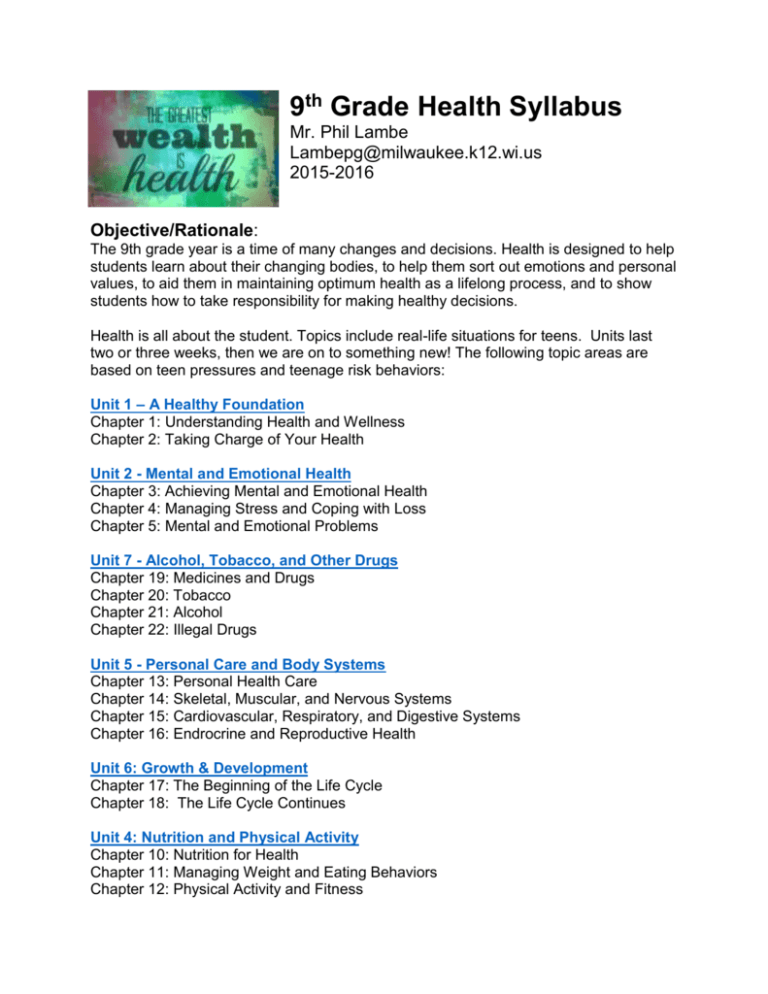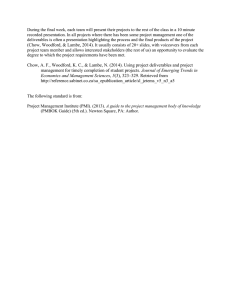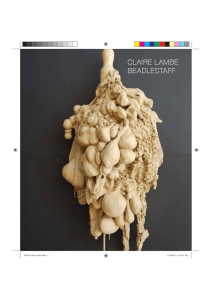File - Mr. Lambe
advertisement

9th Grade Health Syllabus Mr. Phil Lambe Lambepg@milwaukee.k12.wi.us 2015-2016 Objective/Rationale: The 9th grade year is a time of many changes and decisions. Health is designed to help students learn about their changing bodies, to help them sort out emotions and personal values, to aid them in maintaining optimum health as a lifelong process, and to show students how to take responsibility for making healthy decisions. Health is all about the student. Topics include real-life situations for teens. Units last two or three weeks, then we are on to something new! The following topic areas are based on teen pressures and teenage risk behaviors: Unit 1 – A Healthy Foundation Chapter 1: Understanding Health and Wellness Chapter 2: Taking Charge of Your Health Unit 2 - Mental and Emotional Health Chapter 3: Achieving Mental and Emotional Health Chapter 4: Managing Stress and Coping with Loss Chapter 5: Mental and Emotional Problems Unit 7 - Alcohol, Tobacco, and Other Drugs Chapter 19: Medicines and Drugs Chapter 20: Tobacco Chapter 21: Alcohol Chapter 22: Illegal Drugs Unit 5 - Personal Care and Body Systems Chapter 13: Personal Health Care Chapter 14: Skeletal, Muscular, and Nervous Systems Chapter 15: Cardiovascular, Respiratory, and Digestive Systems Chapter 16: Endrocrine and Reproductive Health Unit 6: Growth & Development Chapter 17: The Beginning of the Life Cycle Chapter 18: The Life Cycle Continues Unit 4: Nutrition and Physical Activity Chapter 10: Nutrition for Health Chapter 11: Managing Weight and Eating Behaviors Chapter 12: Physical Activity and Fitness Grading: A student’s grade in Health is a combination of the following (with approximate percentages of total grade): Class work – 40%, which includes individual projects and group/class projects (these assignments may involve graded participation of students during class and cannot be made up; for example, presentations) Tests – 35% Final Exam – 25% Check at any time and see your student’s current grade and if assignments are missing! Grading Scale Advanced (AD) Proficient (PR) Basic (BA) Minimal (MI) The student consistently exceeds course expectations on standards as demonstrated by a body of evidence that shows depth of understanding and flexible application of course concepts. The student consistently meets course expectations on standards as demonstrated by a body of evidence that shows independent understanding and application of course concepts. The student performs just below course expectations on standards as demonstrated by a body of evidence that shows incomplete/inconsistent understanding and application of course concepts. The student performs far below course expectations on standards as demonstrated by a body of evidence that shows limited understanding and application of course concepts. Student Responsibilities: Students are expected to be present and participate in class and turn in homework by assigned due date. (Assignments will be considered late if turned in any time after collected at beginning of class. Late work will only be accepted one week late and will be given a one level grade deduction.) When students miss class it is his/her responsibility to meet with the teacher to find out what they’ve missed. Students are expected to be prepared for and complete exams in class. Class rules include: No put-downs No talking during class when someone else is talking, or disrupting class No mean, rude, or inappropriate comments Respect stuff that’s not yours No switching seats No working on other work during Health No headphones or cell phones allowed in the classroom!! Make-Up/ Extra Credit Assignment Guidelines If a student misses a day they will be allowed to do up to 3 make up assignments per quarter to earn participation points (1 make up assignment is worth 1 day of participation). The following assignment can also be completed for extra credit up to 3 times per quarter. Make up assignment must be turned in within 7 days of the class you missed, unless otherwise discussed. Directions: Choose, read, and print an article from one of the news feeds (including Mr. Lambe's twitter feed) on Mr. Lambe’s PE & Health website (link below). On a separate piece of paper, write or type answers to the following questions and hand in before class. Students should be prepared to give a 1-2 minute summary of their article in class. 1. 2. 3. 4. 5. 6. Summarize the article in one paragraph (5-7 sentences). Explain why you chose this article/topic. Identify 3 things you've learned from this article. Personal reaction: What do you think about this article? Was this article discussing a local, national, or international issue? What questions do you have after reading this article? What would you like to learn more about. Mr. Lambe’s PE & Health Website Link: www.phillambe.weebly.com This website was created to serve as an additional learning resource for students and also to keep parents updated on what’s going on throughout the semester. Students may be required to access the site for class work or homework and will need to access the site to complete make up and extra credit assignments. The site includes: Home page: A new awareness topic each month with information and a link to learn more about it, Mr. Lambe’s Health & Fitness Twitter feed and a comment/feedback box. PE and Health pages: Information on our current unit, exam dates, etc., class highlights, PE and Health ‘Question of the Month, news feeds and links to additional resources, Calendar of external health/fitness activities, a private forum for students to ask health related questions and a link to the text book website which features an online version of the text, quizzes, flashcards, and more! Other Pages include: About Me, Fitness Club and Athletics pages. Your signature for the sexuality opt-out information is only needed if you wish that your child is held from such topics. SEXUALITY OPT-OUT: State law gives parents the right to op their child out of classes on human sexuality issues. MPS schools stress abstinence; however, failure and rate of effectiveness of birth control, risks associated with sexual activity, birth control, and pregnancy are discussed. I wish my student, NAME:__________________________ PERIOD:__________ _____ 1. Reproductive anatomy and related male and female issues/diseases _____ 2. Sexually transmitted infections and HIV/AIDS _____ 3. Failure, effectiveness, and risks of different birth control methods _____ 4. Sexual harassment and assault Parent Name:_______________________ Parent Signature:__________________________ Date:_____________________________ Getting to Know Your Student: Parents: please fill out the following questions. Name:_____________________________________ Period:___ 1. Please list 2-3 of your child’s strengths educationally. 2. Please list 2-3 of your child’s strengths socially and/or in personality/ character. 3. Please list 2-3 things that you feel your child could improve on educationally. 4. Please list 2-3 things that you feel your child could improve on socially or in personality/character. 5. Please list 2-3 of your student’s interests in or out of school. 6. Please list, if any, your child’s medical conditions or special learning issues I need to know. 7. Is there anything else you’d like to share about your child? 8. After looking at the topics on page one of this letter, are there any questions, concerns, or topics you’d like to see covered that aren’t listed?










